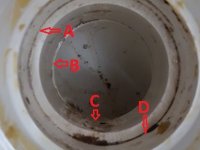Splorg
New Member
I have come here in desperation, as I'm sure many have before. Bear with me as I spin my tale of wastewater woes.
A few nights ago, the toilet in our second floor bathroom began to leak when flushed, and only when flushed, down through the ceiling of the stairwell below it. Not a lot, but enough to rapidly begin rotting away the floor it's mounted to if it's affected, and certainly enough to destroy the ceiling below and our hardwood floors.
I'm certainly not a plumber. Frankly, if not for PEX and SharkBite I'd be the next thing to useless with plumbing tasks; however, I'm pretty handy and of average intelligence, so I figure I can handle this. Of course, I assume that the wax ring has begun to leak, and I am also pretty sure I can make the repair. I've seen it done and assisted a few times, so armed with a new standard wax ring with polypropylene insert, some basic tools and disposable putty knives, I set to work.
I won't bore you with the repair itself, but I did inspect the closet flange (metal flange on PVC, was tight to the floor and didn't appear damaged in any way), and the toilet underside (ceramic intact, no cracks or deformation of any kind that's visible). Satisfied with this, I replaced the closet flange bolts with a pair of new ones I picked up, because, hey, why not, right, install the new ring on the closet flange, and install as indicated otherwise, making sure to keep the toilet level on it's way down, and to level it afterward. Tighten the whole thing up, reattach the water line, double check, turn the water on and watch for leaks. Everything seems good.
Then I flushed it. Good Lord does it leak now!
Puzzled, I turned to YouTube. Sureset bet looks like I'll be installing a new closet flange next. Return to the hardware store, coming home with another wax ring and a new flange kit, the kind that's all PVC with the huge silicone rubber seal on the bottom. Disassemble everything, clean off more stupid gooey sticky wax. Get the rest of my tools, another cup of coffee, and begin mentally stepping through the job to verify I have everythin.....
....then I see it.
I should have known to be on the lookout for some less than logical plumbing work, given the state of some of the other plumbing "repair" the previous owner of our home executed (like the entire undersink drain and the hack job he did to connect the dishwasher) that I've found in our 7 years of living here. If I'm not a plumber, this guy is either a plumbers nightmare or wet dream, if he bills by the hour.
Find attached a photo of the existing flange. Of particular interest is the piece of PVC with saw marks on it that he apparently jammed *inside* the flange. Not shown is the other end of the drain pipe, which he then jammed *over* this smaller piece. The watertight seal it maintained for this long was created by - you guessed it - friction and copious amounts of PVC cement. -_-
My question is this: I'm working an absolute nightmare of a schedule for the next few weeks, and I don't have time to take on a repair of this magnitude; I am also living in a house with 3 women. We have a disused toilet in our basement, but the basement is damp and sort of smelly, and that toilet doesn't like to flush, requiring a good plunging for even a partial flush (a project for another time).
Would it be theoretically possible to affect a TEMPORARY repair, of a few weeks, by caulking the snot out of the joint between the existing flange and the smaller pipe inside it, untill I have time to tear down the ceiling and cut this whole mess out to replace it correctly? I'm thinking of using a waterproof flexible silicone caulking intended for bathrooms and kitchens; letting it cure for 24 hours, and remounting the toilet. Again, this would only be for a few days to two weeks. I can only listen to my wife gripe and my girls complain for so long.
Your thoughts on the matter are appreciated, and thank you in advance for sharing any insight or expertise.
A few nights ago, the toilet in our second floor bathroom began to leak when flushed, and only when flushed, down through the ceiling of the stairwell below it. Not a lot, but enough to rapidly begin rotting away the floor it's mounted to if it's affected, and certainly enough to destroy the ceiling below and our hardwood floors.
I'm certainly not a plumber. Frankly, if not for PEX and SharkBite I'd be the next thing to useless with plumbing tasks; however, I'm pretty handy and of average intelligence, so I figure I can handle this. Of course, I assume that the wax ring has begun to leak, and I am also pretty sure I can make the repair. I've seen it done and assisted a few times, so armed with a new standard wax ring with polypropylene insert, some basic tools and disposable putty knives, I set to work.
I won't bore you with the repair itself, but I did inspect the closet flange (metal flange on PVC, was tight to the floor and didn't appear damaged in any way), and the toilet underside (ceramic intact, no cracks or deformation of any kind that's visible). Satisfied with this, I replaced the closet flange bolts with a pair of new ones I picked up, because, hey, why not, right, install the new ring on the closet flange, and install as indicated otherwise, making sure to keep the toilet level on it's way down, and to level it afterward. Tighten the whole thing up, reattach the water line, double check, turn the water on and watch for leaks. Everything seems good.
Then I flushed it. Good Lord does it leak now!
Puzzled, I turned to YouTube. Sureset bet looks like I'll be installing a new closet flange next. Return to the hardware store, coming home with another wax ring and a new flange kit, the kind that's all PVC with the huge silicone rubber seal on the bottom. Disassemble everything, clean off more stupid gooey sticky wax. Get the rest of my tools, another cup of coffee, and begin mentally stepping through the job to verify I have everythin.....
....then I see it.
I should have known to be on the lookout for some less than logical plumbing work, given the state of some of the other plumbing "repair" the previous owner of our home executed (like the entire undersink drain and the hack job he did to connect the dishwasher) that I've found in our 7 years of living here. If I'm not a plumber, this guy is either a plumbers nightmare or wet dream, if he bills by the hour.
Find attached a photo of the existing flange. Of particular interest is the piece of PVC with saw marks on it that he apparently jammed *inside* the flange. Not shown is the other end of the drain pipe, which he then jammed *over* this smaller piece. The watertight seal it maintained for this long was created by - you guessed it - friction and copious amounts of PVC cement. -_-
My question is this: I'm working an absolute nightmare of a schedule for the next few weeks, and I don't have time to take on a repair of this magnitude; I am also living in a house with 3 women. We have a disused toilet in our basement, but the basement is damp and sort of smelly, and that toilet doesn't like to flush, requiring a good plunging for even a partial flush (a project for another time).
Would it be theoretically possible to affect a TEMPORARY repair, of a few weeks, by caulking the snot out of the joint between the existing flange and the smaller pipe inside it, untill I have time to tear down the ceiling and cut this whole mess out to replace it correctly? I'm thinking of using a waterproof flexible silicone caulking intended for bathrooms and kitchens; letting it cure for 24 hours, and remounting the toilet. Again, this would only be for a few days to two weeks. I can only listen to my wife gripe and my girls complain for so long.
Your thoughts on the matter are appreciated, and thank you in advance for sharing any insight or expertise.




